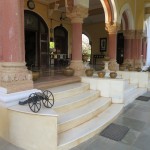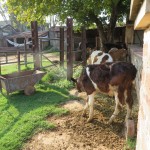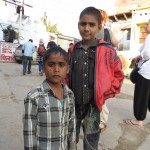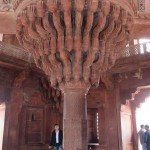Gringos on Parade
- By Katharine
- 1 March, 2014
- 4 Comments
Our visit to Karauli allowed us to look through a kaleidoscope at multiple, parallel Indias. Where Delhi and Jaipur are mostly modern cities with historical landmarks visited by tourists and Indians alike, the Rajasthani “village” of Karauli and the countryside we passed through encompass multiple time periods in terms of technology and manner of living.
On the ride there we passed thatched huts in fields of wheat and mustard, tended and harvested by hand – mostly by women – while tractors chugged alongside our bus on the highway, pulling carts laden with handmade bricks, slabs of red sandstone, sacks of cement, and rocks to build new homes in spreading towns. Patties of cow dung, presumably for use as fuel, dried on stone walls and rural rooftops near electric power substations. Ads for modern products were painted on the sides of trucks with metalwork sides that echo Hindu architecture and cabs decorated like shrines in multi-colored paints, tassles, and sacred slogans. (But all of them have “Horn Please,” or some variant, painted on the back.) Camels pulling carts along the highway were passed by bicycles, scooters, tuk-tuks, and army trucks. Teenage boys dressed in Western clothes and wearing sunglasses, trying to look like their Bollywood idols, chewed paan – a noxious mix of betel leaf and chewing tobacco – and spat red saliva on the pavement. Married Hindu women wore traditional saris and chiffon scarves draped over their faces in public, while children everywhere tried out their singsong English on us: “Hallo!” “How are you?”
Every place we made a scheduled stop for clean, Western-style restrooms also had a restaurant and a gift store where we were urged to buy, buy, buy. The courtesy of the people and the ethic of service are unmatched anywhere I have traveled, but so is the pressure to spend our pounds and dollars. The spirit of desperate capitalism is everywhere, alongside a parallel spiritual India of roadside shrines and temples too numerous to count – and political signs, in advance of the upcoming national elections.
It rained for most of our four-plus hour trip to Karauli, and the smaller roads were a mess of goopy red clay. The sun came out just before we arrived at our “heritage stay,” a massive series of villas owned by the descendants of the former king of Karauli. We had lunch around a massive table in a dining room in the main villa, and dinner around another huge table in a different dining room in another villa. The grounds were extensive, filled with multiple villas interspersed among formal gardens and terraces, a vegetable garden where local people are hired to help grow many of the vegetables we ate, peacocks wandering around, a 10-vehicle garage with some antique cars, and a barnyard, with a chicken coop, horses, and cows who produce the villa’s milk, ghee, and cheese.
The minor royal family who once lived here must have been so extensive that they had to build multiple villas to house their extended family. Four of us single travelers, all women, were in one small building with very steep steps – probably built for a youngest son or a widowed aunt, we decided. It had a little, semi-outdoor living room, a central courtyard, and several guest rooms with large bathrooms. My room had a high ceiling with electric fan, heavy red drapes hanging over wooden-shuttered windows, a high-tech air conditioner with remote control, and a mini-fridge – but no telephone, TV, or wifi, and a hot water tank in the bathroom that had to be switched on 15 minutes before you could take a shower.
After settling in a bit, we took a walk through the villa and the village. I was stunned to learn that this so-called “village” has a population of 150,000 – about the size of New Hampshire’s largest city! The roads were narrow and fairly crowded, lined with shops in rows of tiny, block-walled cubicles that are open in front, although some had a metal pull-down shutter. They sold everything from eggs, fruit, and paneer (yogurt cheese) to batteries, wooden rolling pins and boards for rolling out naan, and cell phones.
As we walked through the narrow streets, trying not to step in cow dung or mud puddles, we passed meandering cows, pigs and goats rooting through garbage, and dogs sleeping anywhere they pleased. Scooters and pedestrians and tuk-tuks – even cars – wove around the animals, often missing them by inches. Plastic garbage lay in piles everywhere, swept up but apparently not collected very often. Yet for all the garbage, Indians do their best to ornament their houses and businesses, painting them in cheerful colors and decorating them with contrasting paint, elaborate metalwork, or beautiful stone carvings. They also ornament themselves. The riot of colors worn by women in traditional dress is always fascinating; I can’t imagine ever getting tired of looking at them.
However, we got more looks than we gave: We were gringos on parade. People stopped to stare at us, school children pursued us, laughing and snapping photos of us with their cellphones, or posing for us so they could see what they looked like in digital replay on our cameras, and finally pitching cricket balls to a couple of the men in our group. Our parade ended up, at last, at the old city palace, where the guards locked the children outside and we went on another tour.
I won’t even try to describe the ornate paintings, the multiple levels, the fantastic arches and screens – once again – that the women stood behind to watch goings-on in the courtyard, or the king’s mirrored and draperied receiving chambers. We had a gorgeous view of the setting sun from the palace roof, and finished our tour in the king’s private temple, adorned with the best Mughal-era paintings I’ve seen yet, of goddesses and tigers, kings on horseback, and elephants. After that it was tuk-tuks back to the villa, a fabulous supper of both chicken and vegetable curries, including a local specialty that combines lentils, spring onions, and other, subtle seasonings, and finally we were off to bed.
Yesterday we rode the bus early to the abandoned city of Fatepur Sikri, which boasts the largest archway in the entire world: an ornamented gateway 54 meters tall that the Emperor Akbar built to commemorate a major military conquest. He established this place as his new capital, but although it took 12 years to build, he abandoned it after living there for only four years because he had to defend his empire from more attacks. He was a very beloved emperor who embraced multiple religions, all of which are symbolized on a magnificent pillar in the center of his private meeting hall. Lore has it that he stood on the central pillar, which is connected by stone bridges to balconies in each of the four corners, while various advisers or diplomats would stand in each corner to discuss and debate with him and others listened respectfully below. He also married three wives of different faiths: a Persian Muslim, who was also a childhood friend and had a tiny palace; a Portuguese Christian princess, Mariam, who had a medium-size palace; and a Hindu, who merited an enormous palace because she bore him a son and heir. He also had more than 300 concubines, who lived in a separate building, and an emperor-sized, huge marble bed, elevated on pillars and reached by a ladder, where he entertained four or five concubines at a time.
Akbar originally came to Fatepur Sikri in search of a famed Sikh guru because he had no legitimate children, either male or female, after seven years. The guru blessed him (and probably told him to fast and lay off the concubines for a while), and after his wives got pregnant, he built a marble shrine to the guru right in the palace grounds. We visited this, first paying outside for small bags of flowers to offer on the shrine – a kind of bed or cushion covered with multiple, brightly colored satin cloths, representing the holy book that is now the Sikh religion’s only guru – and a string to tie around one of the marble screens carved in the walls while praying for a wish to be granted. Musicians played outside, and invited me to sit and sing with them for a bit, before our group moved on.
Other highlights: the lifesize Pachisi (Parcheesi, or Ludo as it’s now called in England and India) board in the center of the main courtyard, where slave girls in brightly colored dresses acted as the pawns, and the winner took home the girls as a prize; the mosque, another Jama Masjid with beautiful gates and minarets; the elaborately carved Astrologer’s Gate; safes in the walls of the money house; a ring for tethering an elephant that acted as executioner, stomping to death anyone convicted by Akbar and his top deputies of murder, rape, or another heinous crime; and a tower studded with stone-carved elephant tusks to commemorate the death of Akbar’s favorite executioner elephant; beautifully carved animals in the Persian queen’s quarters, all of whose faces were chipped away because Muslims are not allowed to make an image of any living creature; and finally our guide.
The only downside was the constant pestering of vendors in virtually every part of the monument. And I fear that will only be worse when we visit the Taj Mahal this morning, and Agra Fort this afternoon.





 Copyright © 2025
Copyright © 2025
Hi Kath.
It is wonderful to read about your adventures and to know you are doing well.the food sounds delicious! It sounds like you’ll get your feet under you just fine for the remaining legs of the trip. I can’t believe it is March 1st and so much time has passed already. Enjoy the rest and be safe. We love you and will be reading along!
So glad I checked your website after not receiving emails. Your trip is sounding GLORIOUS!! I’m anxious to read more.
I am fascinated by your blog entries. Almost like being there. Sounds like you are having a great time.
Love,
John
Dad and I have read your blogs with great interest! What a dream come true this is for you. Hope it continues to be so rewarding!
Love, Mom